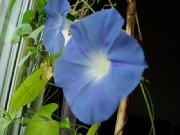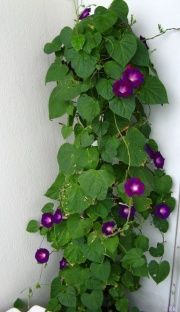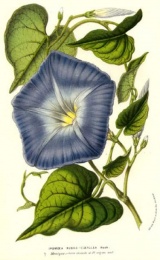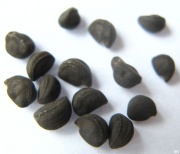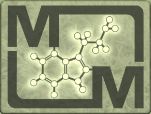 |
MAGISKA MOLEKYLERS WIKI |
Ipomoea
Namn: Morning Glory (en), Praktvindor, Blomman f├Čr dagen (sv)
Inneh├źller: LSA och andra ergotalkaloider
Inneh├źll
Generell information
Sl├żkte i familjen Convolvulaceae.
Bland de k├żnda aktiva arterna ├żr Ipomoea tricolor och Ipomoea purpurea de som ofta ├źterfinns i aff├żrerna och ├żr popul├żra arter att odla f├Čr sina fina blommor. Den art som historiskt har anv├żnts som enteogen av Aztekerna ├żr Ipomoea violacea.
Endofytiska parasitsvampar producerar de aktiva ├żmnena. L├żs mera i artikeln om Convolvulaceae.
Det finns ca 500 olika arter i sl├żktet Ipomoea, det ├żr oklart exakt hur m├źnga av dessa som inneh├źller LSA och liknande ergotalkaloider. Det finns dock forskning som visar att det r├Čr sig om ganska m├źnga arter. Graden av infektion av parasitsvampar inom en kultivar och variationer mellan individuella fr├Čn kan dock avgjort resultatet ├żven i de studier som gjorts och antalet positiva arter ├żr i verkligheten st├Črre.
| ŌĆ£ | The concentrations of ergoline alkaloids and their two-dimensional TLC chromatographic profiles were studied in seeds of 43 spp. of Ipomoea. Some 20% of the species were ergoline alkaloid-positive; elymoclavine was detected in seven of the species studied and lysergol was found in four. Nine species were recorded as positive for the first time. The concentrations of ergoline alkaloid among the positive species range from 0.004% in I. pes-caprae to 0.16% in I. parasitica ŌĆö New sources of ergoline alkaloids within the genus Ipomoea[1] |
ŌĆØ |
Arter
| Latinskt namn | Inneh├źller ergotalkaloider? |
|---|---|
| Ipomoea alba | ? |
| Ipomoea aquatica | ? |
| Ipomoea arborescens | ? |
| Ipomoea argyrophylla | Ja, ergosin, ergosinin, agroclavin[2] |
| Ipomoea asarifolia | Ja |
| Ipomoea batatas | ? |
| Ipomoea bolusiana | ? |
| Ipomoea carnea (Ipomoea fistulosa) | ? |
| Ipomoea coccinea | Ja [3] |
| Ipomoea costata | Ja |
| Ipomoea crassicaulis | ? |
| Ipomoea decasperma | ? |
| Ipomoea hederacea | Ja |
| Ipomoea hederifolia | ? |
| Ipomoea hildebrandtii | Ja, Cycloclavin [4] |
| Ipomoea imperati | ? |
| Ipomoea intrapilosa | ? |
| Ipomoea involucrata | ? |
| Ipomoea lacunosa | Ja |
| Ipomoea leptophylla | ? |
| Ipomoea littoralis | ? |
| Ipomoea medium | ? |
| Ipomoea muelleri | Ja |
| Ipomoea multifida | ? |
| Ipomoea nil | ? |
| Ipomoea pandurata | ? |
| Ipomoea parasitica | Ja |
| Ipomoea pes-caprae | Ja |
| Ipomoea platensis | ? |
| Ipomoea pubescens | ? |
| Ipomoea purpurea | Ja |
| Ipomoea quamoclit | ? |
| Ipomoea sagittata | ? |
| Ipomoea sagittifolia | ? |
| Ipomoea sidaefolia | ? |
| Ipomoea trichocarpa | Ja |
| Ipomoea tricolor (synonymer: Ipomoea rubrocaerulea, Pharbitis rubro-caerulea, Pharbitis tricolor) | Ja [5] |
| Ipomoea tuberosa = Merremia tuberosa | ? |
| Ipomoea villosa | ? |
| Ipomoea violacea | Ja, ergin, isoergin, d-lysergsyrametylkarbinolamid, chanoclavin, elymoclavin, lysergol, ergometrin [6] |
Om inneh├źllet
K├żlla 1
- I. purpurea - 35.4 ug/mg fr├Čn
- I. herderacea - 31.3 ug/mg fr├Čn
- I. lacunosa - 10.8 ug/mg fr├Čn
- I. trichocarpa - 40.0 ug/mg fr├Čn
- I. violaceae v. Heavenly Blue (standard) - 516.0 ug/mg fr├Čn (f├Črmodligen missvisande, aktiv dos hade d├ź varit n├źgra mg fr├Čn)
Alla refererar till mogna fr├Čn, ej torkade. [7]
K├żlla 2 (aktiva arter):
- I. amnicola - 0.039%
- I agrillicola - 0.084%
- I. costata - 0.046%
- I. diamantinensis - 0.018%
- I. muelleri - 0.011%
- I. orizabensis - 0.163%
- I. parasitica - 0.160%
- I. pes-caprae - 0.004%
- I. tricolor Cav. 1 - 0.117%
- I. tricolor Cav. 2 - 0.070%[/quote]
K├żlla: [1]
K├żlla 3
- Ipomoea violacea var. Heavenly Blue, 0.028 - 0.038 vikt% alkaloider
- Ipomoea violacea var. Pearly Gates, 0.040 - 0.072 vikt% alkaloider
- Ipomoea violacea var. Blue Star, 0.022 - 0.032 vikt% alkaloider
Siffrorna refererar till f├żrska fr├Čn. Olika extraktionsmetoder har anv├żnts, med varierande resultat p├ź m├żngden extraherade alkaloider.
Fr├źn fyra olika kromatografiska unders├Čkningar framg├źr det ocks├ź att sammans├żttningen av de ing├źende ergotalkaloiderna varierar mellan olika underarter av Ipomoea violacea.
- Heavenly Blue inneh├źller elymoclavin, ergometrin, agroclavin och LSA, men inte chanoclavin eller penniclavin.
- Pearly Gates inneh├źller chanoclavin, elymoclavin, penniclavin, ergometrin, agroclavin och LSA.
- Blue Star inneh├źller elymoclavin, ergometrin och LSA, men inte chanoclavin, penniclavin eller agroclavin.
K├żlla: [8]
K├żlla 4
| ŌĆ£ | The major alkaloidal components in most of the seeds are the two isomeric amides of lysergic acid, lysergamide (ergine, LAA, LA-111) and isolysergamide (isoergine, iso-LAA). They represent perhaps a half of the alkaloid content of the two badoh's and they are a smaller but sizable component of the baby wood rose. It has been found that the acetaldehyde adduct of these two amides, the N-(l-hydroxyethylamides) accounts for some of the isolated ergines, as this material is quite unstable and is easily converted in the process of isolation. The only other amide of lysergic acid that is present in these plants is ergometrine. All of these are known to have activity in man, and they are specifically described in the commentary located in the LSD recipe in the second half of this volume.
The four lesser alkaloids that are present are all alcohols, reflecting the reduction of the acid group of lysergic acid. The primary reduction product is elymoclavine and the isomer with the double bond moved into conjugation with the aromatic ring is lysergol. This can further hydroxylate to provide penniclavine. And the complete opening of the fourth "D" ring yields chanoclavine. A number of trace alkaloids are also known. |
ŌĆØ |
K├żlla 5
| ŌĆ£ | The analysis of seeds revealed that only three out of five kinds of seeds contained ergot alkaloids, all from ŌĆ£Heavenly BlueŌĆØ cultivar, although from both Ipomoea purpurea and Ipomoea tricolor species (IP-HB, IT-HB1, and IT-HB2). Every time, ergine, ergometrine, LSH, penniclavine, chanoclavine, and their isomers were identified together with a compound that may be lysergol or one of its isobars. Concentration of ergometrine in samples representative for a given seed pack was comparable with results from literature, but concentration in single seeds varied substantially. A similar situation was observed for ergometrine concentration, but there is no data in the literature concerning mean concentration of this compound.
This phenomenon can be a serious concern in the case of people abusing Ipomoea seeds, as there is the possibility of overdosing by either accidentally selecting more potent seeds for ingestion or taking a second dose when the first was less effective than the average. |
ŌĆØ |
Tillredning
OBS! Fr├Čn fr├źn blomsterbutiker ├żr ibland behandlade med medel som d├Čdar parasitsvamparna som skapar ergotalkaloiderna och b├Čr ej anv├żndas.
Fr├Čna mals med kaffekvarn och l├żggs i kallt vatten i flera timmar. Sedan filtreras fr├Čna bort och vattnet dricks. Effekten av LSA liknar en l├źg dos LSD och har en l├źg grad av OEV:s. Trippen varar 5-8 timmar.
H├żlsovarning: LSA och andra ergotalkaloider kan ge kraftig body load, det kan vara jobbigt att f├Črflytta sig, m├źnga beskriver att de f├źr "tr├żningsv├żrk" i olika muskler efter trippen. Sm├żrtor i magen har ocks├ź rapporterats, fr├żmst n├żr fr├Čna bara ├żtits utan tillredning, bieffekterna av extrakt ├żr mildare.
Kan ├żven vara farlig att anv├żnda tillsammans med MAO-h├żmmare. [11]
F├Čr dosering, se Ipomoea violacea. P.g.a olika grad av infektering av parasitsvampar och olika kultivar ├żr en perfekt f├Črsta dosering sv├źr. Den b├żsta kvaliteten n├źs om man odlar fr├Čn fr├źn k├żnda, aktiva batcher och sedan intar en m├żngd f├żrska fr├Čn. Varje planta f├źr flera blommor som i sin tur inneh├źller flera fr├Čn, man kan s├źledes odla fram stora m├żngder med fr├Čn om man har gr├Čna fingrar och n├źgon fin spalje eller liknande d├żr de kan kl├żnga.
Externa l├żnkar
- Ōåæ 1,0 1,1 New sources of ergoline alkaloids within the genus Ipomoea (Amor-Prats, 1993)
- Ōåæ D. Stauffacher, H. Tscherter, and A. Hofmann, Helv. Chim. Acta 48 (1965), 1379.
- Ōåæ D. Gr├Čger, Flora 153 (1963), 373.
- Ōåæ D. Stauffacher, H. Tscherter, and A. Hofmann. Paper read at the 4th International Symposium on the Chemistry of Natural Products of IUPAC, Stockholm, 1966.
- Ōåæ D. Gr├Čger, Flora 153 (1963), 373.
- Ōåæ A. Hofmann and A. Cerletti, Deutsche Med. l┬óochschr. 86 (196t), 885.
- Ōåæ Wilkinson et al, 1986, Can. J. Plant Sci., 66: 339-43
- Ōåæ Extraction and Identification of Clavine and Lysergic Acid Alkaloids from Morning Glories. Ohio J. Sci., No. 4, Vol. 75, pp. 198-201. (Witters, Weldon L, 1975)
- Ōåæ Alexander Shulgin, TIHKAL The Continuation, CHAPTER 17.
- Ōåæ Identification and determination of ergot alkaloids in Morning Glory cultivars (Nowak, 2016)
- Ōåæ Erowid Morning Glory Vault: Basics
Notes on the Present Status of Ololiuhqui and the Other Hallucinogens of Mexico Av Gordon Wasson
Sidan ├żndrades senast 18 augusti 2022 klockan 15.46.
Den h├żr sidan har visats 19┬Ā448 g├źnger.




